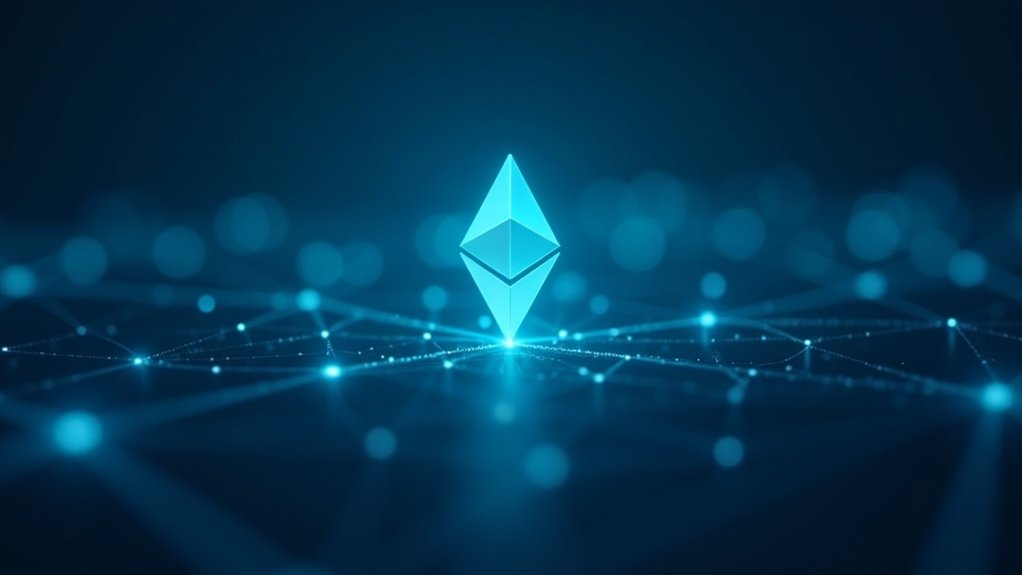Gwei is the standard unit for measuring Ethereum gas fees. It equals one billionth (0.000000001) of an ETH and powers every transaction on the network. Named “gigawei,” it’s part of Ethereum’s denomination system, making transaction costs more readable than microscopic ETH amounts. Gas fees fluctuate based on network congestion and transaction complexity. Users often monitor Gwei rates on platforms like Etherscan. Smart traders plan transactions during off-peak hours. The difference between 45 and 100 Gwei could save you serious cash.
In the vast, often bewildering world of cryptocurrency, Gwei stands as an essential yet frequently misunderstood concept.
It’s actually quite simple: Gwei is a denomination of Ether (ETH), representing one billionth of an ETH.
That’s 0.000000001 ETH, for those keeping score.
It’s named “gigawei,” with “giga” denoting one billion Wei, the smallest unit of Ether.
Unlike other denominations such as Kwei or Mwei, Gwei isn’t named after anyone in particular.
Just a fun fact for your next crypto party.
Gwei plays an essential role in the Ethereum ecosystem.
Gwei isn’t just crypto jargon—it’s the lifeblood of Ethereum’s economic engine, powering every transaction in the network.
It’s how gas fees are calculated.
These fees? They’re what you pay for the privilege of doing anything on the Ethereum network.
Every transaction costs gas.
Every smart contract execution costs gas.
And all that gas is priced in Gwei.
The base fee model helps improve transparency and predictability in gas pricing.
Not in full ETH—that would be ridiculous for most transactions.
Imagine buying coffee with hundred-dollar bills only.
The beauty of Gwei is its practicality.
It makes transaction costs human-readable.
Instead of dealing with a string of zeros, users can quickly compare and understand fees.
“This transaction costs 45 Gwei” is much clearer than “0.000000045 ETH.”
See the difference?
It matters.
These fees fluctuate wildly based on network congestion and transaction complexity.
Peak hours? Prepare to pay more.
Complex smart contract interaction? Open your wallet wider.
Some savvy users optimize by transacting during off-peak hours.
Smart move.
Ethereum’s denomination system extends beyond Gwei.
From Wei at the smallest end to ETH itself, each denomination serves different purposes.
Some honor mathematicians and cryptographers—a nerdy but respectful nod to intellectual foundations.
For everyday Ethereum users, understanding Gwei isn’t just academic—it’s financial common sense.
It determines how much you’ll pay validators (formerly miners) for their computational work.
Users often check platforms like Etherscan to monitor current gas prices in real-time.
A standard ETH transfer typically requires a gas limit of 21,000 units, which forms the baseline for calculating transaction costs.
Those validators? They’re not running charity operations.
They want compensation for their efforts.
And that compensation comes in Gwei-calculated gas fees.
Know it.
Use it.
Respect it.
Frequently Asked Questions
How Do I Calculate the Total Cost of an Ethereum Transaction?
To calculate Ethereum transaction cost, multiply gas used by gas price (in Gwei). Simple formula: Gas Used × Gas Price = Total Fee in ETH.
Post-EIP-1559, this includes a base fee (burned) plus priority fee (for validators).
Network congestion? Higher fees. Complex smart contract? More gas needed.
The math isn’t rocket science, but timing matters.
Weekend transactions are often cheaper.
And remember, unused gas gets refunded. Small consolation when network’s jammed.
Can I Manually Adjust Gwei to Save on Transaction Fees?
Yes, users can manually adjust Gwei in most crypto wallets.
MetaMask and MyEtherWallet offer this feature.
Lower Gwei means cheaper transactions, but might take longer to process.
Too low? Transaction could fail completely.
Network congested? Higher Gwei needed.
It’s a balancing act.
Some people wait for off-peak hours when fees naturally drop.
Layer 2 solutions are another option.
The EIP-1559 update made the whole process slightly more predictable.
When Are Ethereum Gas Fees Typically Lowest?
Ethereum gas fees typically hit rock bottom during weekends—particularly Sundays.
No surprise there.
Network congestion drops when traders take a break.
Early mornings (2-6 AM EST) also see cheaper transactions.
Why?
Americans are sleeping, Europeans are just waking up.
Smart traders monitor tools like Etherscan for real-time data, spotting those sweet low-fee windows.
Major ICOs and US business hours?
Forget it.
Fees skyrocket when the network gets clogged with transactions.
How Do Layer-2 Solutions Affect Gwei and Gas Costs?
Layer-2 solutions dramatically slash gas fees—sometimes by up to 99%.
They work by processing transactions off-chain or bundling them together before hitting the main blockchain.
Less congestion equals lower costs.
Period.
While users still pay in gwei, the actual amount needed plummets.
Optimistic Rollups and ZK-Rollups are the heavy hitters here.
They maintain Ethereum’s security but make transactions dirt cheap—often just pennies compared to Layer-1’s wallet-draining fees.
Will Ethereum 2.0 Eliminate the Need for Gwei Calculations?
No, Ethereum 2.0 won’t eliminate Gwei calculations.
Despite the shift to Proof of Stake and improved scalability, Gwei remains essential for expressing gas fees. The system still needs precise units for transaction costs.
Sure, fees might drop dramatically—potentially below $0.001—but they’ll still exist.
EIP-1559’s base fee and priority fee structure actually makes Gwei calculations more relevant than ever. Different mechanism, same measuring stick. The crypto world’s stubborn like that.









